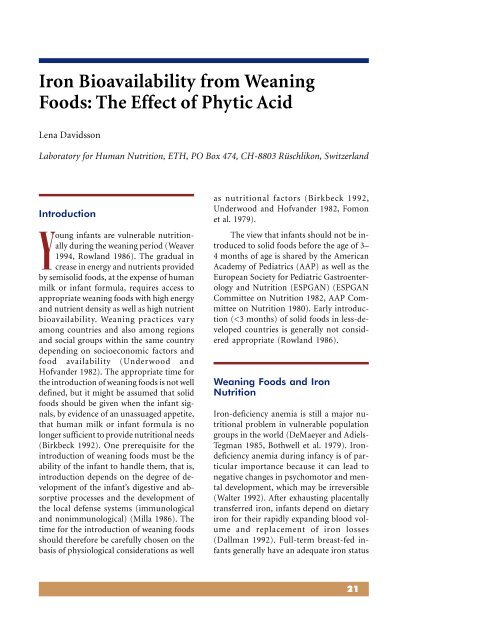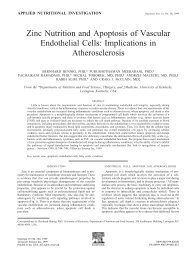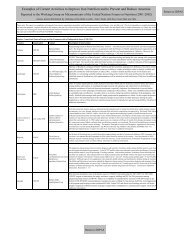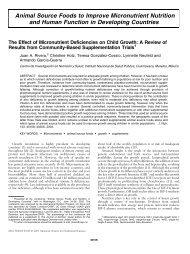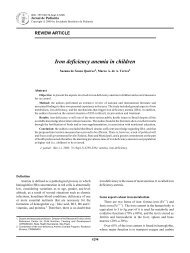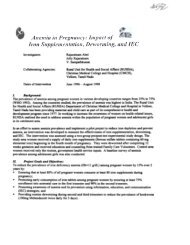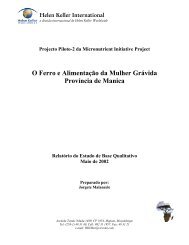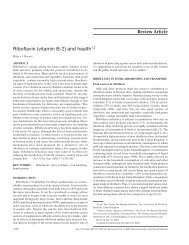Micronutrient Interactions: Impact on Child Health and ... - Idpas.org
Micronutrient Interactions: Impact on Child Health and ... - Idpas.org
Micronutrient Interactions: Impact on Child Health and ... - Idpas.org
You also want an ePaper? Increase the reach of your titles
YUMPU automatically turns print PDFs into web optimized ePapers that Google loves.
Ir<strong>on</strong>–ascerbic Acid <strong>and</strong> Ir<strong>on</strong>–calcium <str<strong>on</strong>g>Interacti<strong>on</strong>s</str<strong>on</strong>g> <strong>and</strong> Their Relevance in Complementary Feeding<br />
Ir<strong>on</strong> Bioavailability from Weaning<br />
Foods: The Effect of Phytic Acid<br />
Lena Davidss<strong>on</strong><br />
Laboratory for Human Nutriti<strong>on</strong>, ETH, PO Box 474, CH-8803 Rüschlik<strong>on</strong>, Switzerl<strong>and</strong><br />
Introducti<strong>on</strong><br />
Young infants are vulnerable nutriti<strong>on</strong>ally<br />
during the weaning period (Weaver<br />
1994, Rowl<strong>and</strong> 1986). The gradual in<br />
crease in energy <strong>and</strong> nutrients provided<br />
by semisolid foods, at the expense of human<br />
milk or infant formula, requires access to<br />
appropriate weaning foods with high energy<br />
<strong>and</strong> nutrient density as well as high nutrient<br />
bioavailability. Weaning practices vary<br />
am<strong>on</strong>g countries <strong>and</strong> also am<strong>on</strong>g regi<strong>on</strong>s<br />
<strong>and</strong> social groups within the same country<br />
depending <strong>on</strong> socioec<strong>on</strong>omic factors <strong>and</strong><br />
food availability (Underwood <strong>and</strong><br />
Hofv<strong>and</strong>er 1982). The appropriate time for<br />
the introducti<strong>on</strong> of weaning foods is not well<br />
defined, but it might be assumed that solid<br />
foods should be given when the infant signals,<br />
by evidence of an unassuaged appetite,<br />
that human milk or infant formula is no<br />
l<strong>on</strong>ger sufficient to provide nutriti<strong>on</strong>al needs<br />
(Birkbeck 1992). One prerequisite for the<br />
introducti<strong>on</strong> of weaning foods must be the<br />
ability of the infant to h<strong>and</strong>le them, that is,<br />
introducti<strong>on</strong> depends <strong>on</strong> the degree of development<br />
of the infant’s digestive <strong>and</strong> absorptive<br />
processes <strong>and</strong> the development of<br />
the local defense systems (immunological<br />
<strong>and</strong> n<strong>on</strong>immunological) (Milla 1986). The<br />
time for the introducti<strong>on</strong> of weaning foods<br />
should therefore be carefully chosen <strong>on</strong> the<br />
basis of physiological c<strong>on</strong>siderati<strong>on</strong>s as well<br />
as nutriti<strong>on</strong>al factors (Birkbeck 1992,<br />
Underwood <strong>and</strong> Hofv<strong>and</strong>er 1982, Fom<strong>on</strong><br />
et al. 1979).<br />
The view that infants should not be introduced<br />
to solid foods before the age of 3–<br />
4 m<strong>on</strong>ths of age is shared by the American<br />
Academy of Pediatrics (AAP) as well as the<br />
European Society for Pediatric Gastroenterology<br />
<strong>and</strong> Nutriti<strong>on</strong> (ESPGAN) (ESPGAN<br />
Committee <strong>on</strong> Nutriti<strong>on</strong> 1982, AAP Committee<br />
<strong>on</strong> Nutriti<strong>on</strong> 1980). Early introducti<strong>on</strong><br />
(


